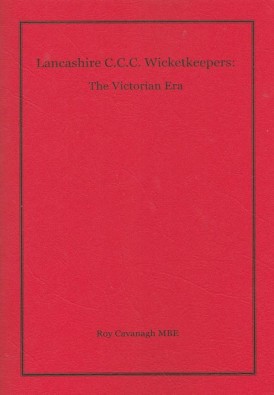Lancashire CCC Wicketkeepers: The Victorian Era
Martin Chandler |Published: 2017
Pages: 24
Author: Cavanagh, Roy
Publisher: Red Rose Books
Rating: 3.5 stars

It’s been a while since we have had anything new from Roy Cavanagh, an occasional author on the subject of Lancastrian cricket. He has previously written short pamphlets on Colin Hilton and Mudassar Nazar (an honorary Lancastrian), and co-wrote the booklet about Cyril Washbrook in the ACS Famous Cricketers series. He has also authored a history of the Bolton League, a small book about Lancashire captains and a modest summary of the lives of the cricketing Tyldesleys of Westhoughton and Roe Green. Possibly the best of the lot, and I believe chronologically the most recent, was an enjoyable book about the lives of two double internationals, Harry Makepeace and Jack Sharp, Lancastrians of course.
For the future, this small booklet is intended to be the first of a series that will eventually contain pen portraits of all the men who have been selected to keep wicket for Lancashire since the county club made its First Class bow in 1865. Covered here are the first 35 years. There are 33 men profiled three of whom need little or no introduction to followers of Lancashire cricket. Or at least that is what is written in the summary on the rear wrapper. In truth that sets the bar rather high. I would unhesitatingly describe myself as a follower of Lancashire cricket and am certainly familiar with the deeds and reputation of Richard Pilling. The two other men I should know are Arthur Kemble, whose name did ring a bell even if I didn’t recognise him as a Lancashire stumper, but I must confess the name of Charles Smith had not taken root in my mind before I read Lancashire CCC Wicketkeepers: The Victorian Era, despite his being a member of a championship winning Lancashire side.
By its nature this slim volume is primarily going to appeal to Lancastrians, although it will certainly raise at least an eyebrow for my fellow Redingensian Keith Walmsley, author of the splendid pair of titles Brief Candles and Brief Candles 2. Amongst the 33 is Richard Boys, one of the subjects of Brief Candles 2, who played his solitary First Class match in 1877 – what are the odds on such a man, who other than the tragic circumstances of his passing achieved nothing of great note in his life, featuring in two cricket books inside eighteen months 120 years after his death?
Equally remarkable to this reviewer is that Boys is not the only ‘brief candle’ in the 33 – in fact there are as many as ten of them. I am no mathematician but even I can work out that for Victorian Lancashire wicketkeepers that rises to 30% – one to ponder.*
Not unreasonably five of Cavanagh’s 24 pages are taken up with Pilling, whilst Kemble and Smith get one and two respectively, so many of these biographies are but a handful of paragraphs, some necessarily so because important details have defied even Cavanagh’s diligent research. In one case the identity of the individual concerned, R Roberts, is not entirely clear in itself. Strangely Roberts is not one of the aforementioned ten, and perhaps surprisingly comes in as high as thirteenth in the list if judged on appearances alone.
It would be fair to say that Lancashire CCC Wicketkeepers: The Victorian Era is a modest little publication, albeit one that is attractively produced in the same style as many of Red Rose Books’ similar efforts. It appears in a signed and numbered limited edition of 100 copies and is obtainable from Red Rose at the modest cost of £7.95 including UK postage. So restricted is its appeal that I dare say it will take a while for that 100 to sell, but it is a fascinating little booklet if you like that sort of thing.
*Such was my curiosity that I asked the learned Mr Walmsley about this. He cautioned me that the statistics are not readily available to give a definitive answer to the question, but to my eternal gratitude he went on to humour me by setting his mind to the problem. His estimate is that the overall figure is about one in six, so 16%, rising in the case of players debuting before 1899 to 25%.







Leave a comment